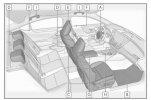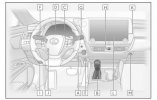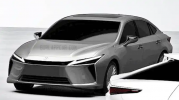You are using an out of date browser. It may not display this or other websites correctly.
You should upgrade or use an alternative browser.
You should upgrade or use an alternative browser.
REVEALED! 8th Generation Lexus ES Megathread (ES 350h, ES 350e, ES 500e)
- Thread starter Gecko
- Start date
CRSKTN
Expert
- Messages
- 2,414
- Reactions
- 4,046
More involvement from Toyota in how Toyota's are created I imagine (it sounds funny). If i'm not mistaken, currently OEMs basically piece together vehicles largely from offerings from suppliers (e.g. door handles, headlight projectors, etc). More stuff than you'd expect in cars like the Camry aren't actually engineered inhouse.
I imagine ODM is more involvement with the design and customization/origination of those components so you get better, more economic outcomes vs making existing things work.
Please someone correct me if i'm wrong.
I imagine ODM is more involvement with the design and customization/origination of those components so you get better, more economic outcomes vs making existing things work.
Please someone correct me if i'm wrong.
This is an oversimplification. Yes, automakers use common parts across multiple model lines but they don't just piece together their cars from commodity parts picked from large bins on the assembly line floor.More involvement from Toyota in how Toyota's are created I imagine (it sounds funny). If i'm not mistaken, currently OEMs basically piece together vehicles largely from offerings from suppliers (e.g. door handles, headlight projectors, etc). More stuff than you'd expect in cars like the Camry aren't actually engineered inhouse.
I imagine ODM is more involvement with the design and customization/origination of those components so you get better, more economic outcomes vs making existing things work.
Please someone correct me if i'm wrong.
All cars go through a long (years-long) and complicated engineering and styling design process, and only late in that process do the engineers do a "buy or build" decision to determine if they should (and can) buy a part (or subassembly) from a supplier, or build in-house. But even if they do buy from suppliers, the automakers provide specifications to suppliers so that the bought-in products are better-suited for a model line(s) rather than being true parts-bin products.
Of course, this process will depend to a large extent on how vertically-oriented an automaker is. Highly-vertically-oriented companies, like Tesla (and Chinese automakers, as I understand it, but I could be wrong) will build more in-house and buy little from outside suppliers. Western automakers like Ford and GM buy a lot from outside suppliers.
Toyota is somewhere in the middle. They do buy from suppliers but their suppliers, especially in Japan, are largely companies that are in the Toyota "family".
Automakers decide on vertical-orientation in large part to keep quality high and to keep costs low; these were the reasons Tesla has given for being vertically-oriented (but I can see how expensive it can be to have to re-invent the wheel every time Tesla has to design and build a new seat, for example, rather than working with a specialty auto-seat maker). Toyota's (and the Japanese and Korean) culture of in-house / in-family suppliers keeps quality high because the automakers maintain control of their suppliers but the suppliers are also able to sell those parts to other automakers as commodity items (thus lowering costs).
GM and Ford used to have their own families of suppliers but divested sold them off.
I still do not know what "ODM" stands for.
On the most extreme end is vertical integration. All processes involved in making the product are done in-house. Example is Tesla and BYD.
In between is OEM. The car company is responsible for the design of components which are then manufactured by 3rd party suppliers. Some times the car company owns majority of its Tier 1 suppliers such as TMC and Hyundai.
Then there is ODM. The car brand only does sales and marketing. The actual car is manufactured and designed by an ODM. Example is Toyota BZ3 (manufactured and designed by BYD), Mazda EZ-6 (Chang'an), Polestar 4 (Geely).
In between is OEM. The car company is responsible for the design of components which are then manufactured by 3rd party suppliers. Some times the car company owns majority of its Tier 1 suppliers such as TMC and Hyundai.
Then there is ODM. The car brand only does sales and marketing. The actual car is manufactured and designed by an ODM. Example is Toyota BZ3 (manufactured and designed by BYD), Mazda EZ-6 (Chang'an), Polestar 4 (Geely).
CRSKTN
Expert
- Messages
- 2,414
- Reactions
- 4,046
parts bin is going too far but some major models from Toyota have a lot of their engineering done outside Japan by firms in places like India. I was surprised to find out.
I think Oem vs Odm is just being pedantic on how involved they are with their suppliers.
I think Oem vs Odm is just being pedantic on how involved they are with their suppliers.
Ian Schmidt
Moderator
- Messages
- 2,404
- Reactions
- 4,245
In a lot of cases computer modules for things like anti-lock brakes are a stock part from a company like Bosch, but the firmware running on them has customization options that different makers set differently.
The further something is from defining the car, the more likely it's outsourced. Even Tesla uses off-the-shelf pedal assemblies that are also used by at least Mercedes-Benz and Ford. Whereas the powertrain and infotainment are almost never left to anyone else.
The further something is from defining the car, the more likely it's outsourced. Even Tesla uses off-the-shelf pedal assemblies that are also used by at least Mercedes-Benz and Ford. Whereas the powertrain and infotainment are almost never left to anyone else.
Fisker was ODM - everything was built by suppliers, and outside factories.
Lots of issues messed up the whole brand.
Same suppliers do a lot better job with same technology when integration is done by manufacturers.
Thus the real difference in OEM vs ODM
Lots of issues messed up the whole brand.
Same suppliers do a lot better job with same technology when integration is done by manufacturers.
Thus the real difference in OEM vs ODM
Sadly they removed the hvac switches but surprisingly looks like it will still have the analog clock
Kelvin2020
Admirer
- Messages
- 859
- Reactions
- 2,000
This screen looks so weird on ES, it doesn’t fit at all. The current one is good enough, I don’t think they should change it.
Gor134
Expert
- Messages
- 1,144
- Reactions
- 2,026
Found more:
2025新款es 11.15发布
I'm confused. This is the 2025 ES for China, but why is it different from the US version?
And no, it looks like it is just a model year update, not the rumored major facelift.
2025新款es 11.15发布
I'm confused. This is the 2025 ES for China, but why is it different from the US version?
And no, it looks like it is just a model year update, not the rumored major facelift.
Kelvin2020
Admirer
- Messages
- 859
- Reactions
- 2,000
Maybe this refresh only for China?Found more:
2025新款es 11.15发布
I'm confused. This is the 2025 ES for China, but why is it different from the US version?
And no, it looks like it is just a model year update, not the rumored major facelift.
Found more:
2025新款es 11.15发布
I'm confused. This is the 2025 ES for China, but why is it different from the US version?
And no, it looks like it is just a model year update, not the rumored major facelift.
this looks like MMC, which is what we call a facelift, just like 2022.
Also, it is like RZ screen so hvac is integrated into screen physical buttons

F1 Silver Arrows
Expert
- Messages
- 2,573
- Reactions
- 4,180
the thumbnails... the freakin' thumbnails...
Kelvin2020
Admirer
- Messages
- 859
- Reactions
- 2,000
-
This site uses cookies to help personalise content, tailor your experience and to keep you logged in if you register.
By continuing to use this site, you are consenting to our use of cookies.






